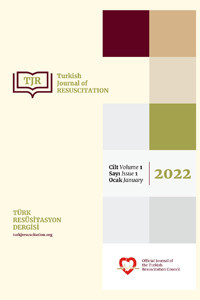SERVİKAL EPİDURAL NÖROPLASTİ SIRASINDA KARDİYAK ARREST GELİŞEN HASTADA RESÜSİTASYON SIRASINDA İV LİPİD EMÜLSİYON KULLANIMI
'Servikal epidural nöroplasti' servikal diskopati tedavisinde olduğu gibi akciğer kanserinin apeks tutulumlarında özellikle dermatomal ekstremite yayılımlarının tedavisinde uygulanabilen bir tedavi yöntemidir. Servikal lokal anestezik uygulamalarında da lokal anesteziklere ait olumsuz bir yan etki olan sistemik toksik reaksiyon ve kardiyopulmoner arrest gelişebilir. Burada, hızlı müdahalenin, etiyolojik nedenlerin göz önünde bulundurulmasının ve kardiyopulmoner resüsitasyon devam ederken lipid solüsyonunun uygulanmasının başarılı sonuçlar açısından önemini vurgulayan bir olgu sunulmaktadır.
Anahtar Kelimeler:
Servikal epidural nöroplasti, Lokal anestezik, Kardiyopulmoner resüsitasyon, Lipid emülsiyonu
USE OF IV LIPID EMULSION FOR THE RESUSCITATION OF A PATIENT WHO DEVELOPS CARDIAC ARREST DURING CERVICAL EPIDURAL NEUROPLASTIA
Cervical epidural neuroplasty is a treatment method that can be applied in the treatment of apex involvement of lung cancer, especially in the treatment of dermatomal extremity spread, as well as the treatment of cervical discopathy. Systemic toxic reaction and cardiopulmonary arrest, which is an adverse effect of local anaesthetics, may also develop in cervical local anaesthetic applications. Here, we present a case emphasizing the importance of rapid intervention, consideration of etiologic causes, and administration of lipid solution during cardiopulmonary resuscitation for successful outcomes.
Keywords:
Cervical epidural neuroplasty, Local anesthetic, Cardiopulmonary resuscitation, Lipid emulsion,
___
- Hochberg U, Elgueta MF, Perez J. Interventional Analgesic Management of Lung Cancer Pain. Front Oncol. 2017;7:17.
- Epstein NE. The Risks of Epidural and Transforaminal Steroid Injections in the Spine: Commentary and a Comprehensive Review of the Literature. Surg Neurol Int. 2013;4:S74-S93.
- World Health Organization (WHO), Expert Committee on the Selection and Use of Essential Medicines. Executive Summary: The Selection and Use of Essential Medicines. Geneva, Switzerland: who; 2017. [Available online at: http://www.who.int/medicines/publications/essentialmedicines/EML_2017_ExecutiveSummary.pdf?ua=1; cited 10 September 2018].
- International Narcotics Control Board (INCB) Report of the International Narcotics Control Board on the Availability of Internationally Controlled Drugs: Ensuring Adequate Access for Medical and Scientific Purposes. Vienna, Austria: incb; 2010. [Available online at: https://www.unodc.org/documents/lpo-brazil/noticias/2011/03-marco/Jife/Report_of_the_Board_on_the_availability_of_controlled_substances.pdf; cited 10 September 2018].
- Taşkaynatan MA. Omurga Hastalıklarının Tedavisinde Algologun Rolü. The Role of an Algologist in the Treatment of Spine Disorders Türkiye Review DOI: 10.4274/tftr.86094.
- Manchikanti L, Datta S, Gupta S, Munglani R, Bryce DA,Ward SP, et al. A Critica Review of the American Pain Society Clinical Practice Guidelines for Interventional Techniques: Part 2. Therapeutic Interventions. Pain Physician. 2010;13:E215-E264.
- Rotschild L, et al. Lipid emulsion in clinical toxicology. Scand J Trauma Resusc Emerg Med. 2010;18:5.
- Ok SH, Hong JM, Lee SH, Sohn JT. Lipid Emulsion for Treating Local Anesthetic Systemic Toxicity Int J Med Sci. 2018;15(7):713-22.
- Cao D, Heard K, Foran M, Koyfman A. Intravenous Lipid Emulsion in the Emergency Department: A Systematic Review ff Recent Literature. J Emerg Med. 2015;48:387-97.
- Rosenblatt MA, Abel M, Fischer GW, Itzkovich CJ, Eisenkraft JB. Successful use of a 20% lipid emulsion to resuscitate a patient after a presumed bupivacaine-related cardiac arrest. Anesthesiology. 2006;105:217-8.
- Başlangıç: 2022
- Yayıncı: Resüsitasyon Derneği
Sayıdaki Diğer Makaleler
NEFESLE BAŞLAR YOLCULUK!: KARDİYOPULMONER RESÜSİTASYONDA TARİHSEL BİR GEZİNTİ
Aslı KARSLI KOÇ, Hatice Evren EKER, Çağla Etike BALİ, Anış ARIBOĞAN, Şule AKIN
Nurcan DORUK, Levent ÖZDEMİR, Aslınur SAGÜN, Bahar TAŞDELEN, Merve KÖK, Enes YEŞİLMEN
Y. Levent UĞUR, Murat ÖZÇELİK, Şule ÖZBİLGİN, Bahar KUVAKİ, Necati GÖKMEN
ÇOKLU BAŞARILI RESÜSİTASYON VE AKUT KORONER SENDROMLU HASTAYA YAKLAŞIM
Tarık KAÇAR, Ali ALAGÖZ, Gönül TEZCAN KELEŞ
DOKUZ EYLÜL ÜNİVERSİTESİ TIP FAKÜLTESİ HASTANESİNDE MAVİ KOD UYGULAMALARININ DEĞERLENDİRİLMESİ
Neslihan TÜTÜNCÜ KILIÇ, Bahar KUVAKİ, Şule ÖZBİLGİN, Mert İNCESU
